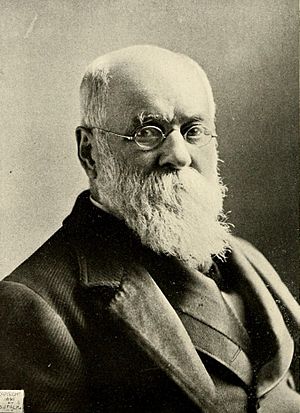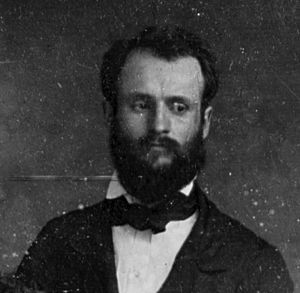Charles Anderson Dana facts for kids
Quick facts for kids
Charles Anderson Dana
|
|
|---|---|
 |
|
| Born | August 8, 1819 |
| Died | October 17, 1897 (aged 78) Long Island, New York, US
|
| Occupation | Journalist Newspaper editor |
| Relatives | Ruth Draper (granddaughter) |
| Signature | |
Charles Anderson Dana (born August 8, 1819 – died October 17, 1897) was an important American journalist and writer. He also worked as a senior government official.
He was a main helper to Horace Greeley as the managing editor of the New-York Tribune newspaper until 1862. During the American Civil War, he served as Assistant Secretary of War. In this role, he helped connect the War Department with General Ulysses S. Grant. In 1868, he became the editor and part-owner of The New York Sun. He first wrote for working-class people. Later, after 1890, he supported business-focused ideas. Dana loved collecting art, especially paintings and porcelains. He was proud to own many unique items.
Contents
Early Life and Education
Charles Dana was born in Hinsdale, New Hampshire, on August 8, 1819. His family came from Richard Dana, who moved from England to America in 1640.
When Charles was twelve, he worked as a clerk in his uncle's store in Buffalo. The store closed in 1837. After that, he started studying Latin grammar to prepare for college. In 1839, he began studying at Harvard. However, his eyesight became poor, forcing him to leave college in 1841. He also gave up his plans to study in Germany and become a minister.
From 1841 to 1846, he lived at Brook Farm. This was a special community where people tried to live and work together. He was a trustee there and helped manage the farm's money. While at Brook Farm, he also wrote for a publication called the Harbinger. In 1846, he married Eunice Macdaniel.
Journalism Career
Dana wrote for and managed the Harbinger, which was a publication from Brook Farm. It focused on social improvements and literature. From 1844, he also wrote for and edited the Boston Chronotype for two years.
In 1847, he joined the New York Tribune newspaper. In 1848, he wrote letters from Europe about the revolutionary movements happening there. He even visited Karl Marx in Cologne. From 1852 to 1861, Marx was a writer for the New York Daily Tribune.
Dana returned to the Tribune in 1849 and became its managing editor. He strongly supported the anti-slavery cause. He helped shape the newspaper's views when Horace Greeley was unsure. The Tribune became very popular before the American Civil War. This was partly because of Dana's talent for journalism. He helped make the Tribune a leading voice against slavery.
In 1861, Dana tried to help Greeley become a candidate for the U.S. Senate. He almost succeeded. However, Greeley's supporters lost to another candidate.
During the first year of the Civil War, Dana and Greeley had different ideas about how to fight the war. Because of these disagreements, Dana was asked to resign from the Tribune in 1862.
Civil War Service
After leaving the Tribune, Secretary of War Edwin M. Stanton made Charles Dana a special commissioner for the War Department. This was during the American Civil War. In this role, Dana found problems with how supplies were managed. He also found people illegally trading cotton with the enemy.
President Abraham Lincoln called Dana "the eyes of the administration." Dana spent a lot of time at the front lines. He sent frequent reports to Secretary Stanton about the generals. Dana spent much time with General Grant and became a close friend. He told Stanton that Grant was "modest, honest, and thoughtful." He also said Grant had "courage that never faltered."
Dana was with Grant during the Vicksburg Campaign. He was also present at the Battle of Chickamauga and the Chattanooga Campaign. He strongly suggested that General Grant should lead all the armies. Lincoln agreed and gave Grant this command on March 2, 1864.
After returning to Washington, Dana became the Assistant Secretary of War. He held this job from 1863 to 1865. Dana had a big influence on Grant's military career.
Return to Journalism and The Sun
In 1865–1866, Dana worked for the Chicago Republican newspaper. In 1868, he became the editor and part-owner of The Sun, a newspaper in New York City. He stayed in charge of The Sun until he died.
When he took over, he said his goal was:
It will study condensation, clearness, point, and will endeavor to present its daily photograph of the whole world's doings in the most luminous and lively manner.
Under Dana's leadership, The Sun did not support the effort to remove President Andrew Johnson from office. It supported Grant for president in 1868. However, it later became a strong critic of Grant as president. In 1872, The Sun supported Horace Greeley for president.
Dana made The Sun a Democratic newspaper. It was very independent and spoke its mind about both political parties. His criticisms of the government under President Grant led to a legal challenge in 1873. Dana faced charges of libel, but a judge ruled that the proposed trial was unfair. Dana's personality became strongly linked with the newspaper he edited.
In 1876, The Sun supported Samuel J. Tilden for president. It disagreed with the special commission that decided the election. It often called Rutherford B. Hayes the "fraud president."
In 1884, The Sun supported Benjamin Butler for president. It opposed James G. Blaine and even more strongly opposed Grover Cleveland. The newspaper's circulation reached about 150,000 copies. However, when Joseph Pulitzer started the New York World, The Sun's sales dropped. Dana was an old-fashioned publisher. He did not trust new printing machines like the Linotype. He relied on selling the paper for two cents, not on advertising.
In 1888, The Sun supported Cleveland, even though it had criticized his first term. It also criticized almost everything about his second term, except for the government's involvement in the Pullman Strike of 1894. In 1896, on the free silver issue (a debate about money), it opposed William Jennings Bryan. Over time, The Sun changed from supporting working-class people to strongly supporting the business community.
Writing and Other Works
Dana's writing style became the style of The Sun: simple, strong, clear, and to the point. He believed in common sense and human interest in news. He disliked long, unclear writing. Three of his talks on journalism were published in 1895 as Art of Newspaper Making.
With George Ripley, he edited The New American Cyclopaedia (1857–1863). This was later reissued as the American Cyclopaedia in 1873–1876.
Dana also loved literature. His first book was a collection of stories translated from German, called The Black Aunt (1848). In 1857, he edited a poetry collection called The Household Book of Poetry. He also translated a German fairy tale, "Nutcracker and Sugardolly," in 1856. Besides German, Dana could read Romance and Scandinavian languages. With Rossiter Johnson, he edited Fifty Perfect Poems (1883).
Dana edited The Life of Ulysses S. Grant: General of the Armies of the United States, published in 1868. His own books, Recollections of the Civil War and Eastern Journeys: Some Notes of Travel in Russia, in the Caucasus, and to Jerusalem, were published in 1898.
Art Collecting
Dana was a big art collector. In 1880, he built a large home in New York City. He filled it with paintings, tapestries, and Chinese porcelains. He spent the most time and study on his porcelains. One art expert praised his collection, saying that many items were not found in famous museums like the British Museum or the Louvre.
See also
- Bibliography of the American Civil War
- Bibliography of Ulysses S. Grant


